PRINCETON, NJ -- Halloween seemed to cheer consumers, with Gallup's Economic Confidence Index improving to its best level of the past several weeks, while the job situation returned to its improved trend -- marking its seventh consecutive week of zero or greater readings -- and consumer spending improved to its "paycheck week" trend.
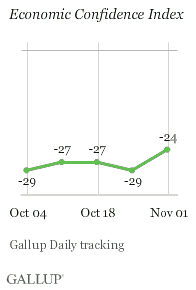
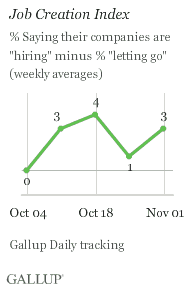
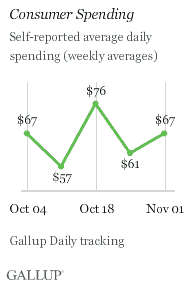
What Happened (Week Ending Nov. 1)
-
Economic Confidence grew slightly during Halloween week, as Gallup's Economic Confidence Index improved to -24 -- its best reading since its 2009 best of -20 during the week ending Sept. 27. The improvement is mostly due to slightly more optimistic assessments of the economy's course, with 40% of Americans describing the economy as "getting better" -- up three points from the prior week and four points from a month ago -- while 55% say the economy is "getting worse," an improvement from 58% readings of the prior week and a month ago. Meanwhile, "poor" ratings of the economy, now 45%, are about the same as a month ago (46%), while "excellent"/"good" ratings, at 12%, are also comparable to a month ago (11%). Halloween celebrations and reports of strong economic growth during the third quarter seem to have buoyed consumers' economic perceptions as October ended.
-
Job Creation also improved slightly last week, with Gallup's Job Creation Index increasing to +3 -- up from +1 the prior week and nearly matching the best level of 2009 recorded two weeks ago. The Job Creation Index has had readings of zero or more for seven consecutive weeks, the longest such stretch since last year. Twenty-six percent of employees say their companies are hiring -- up two points from the prior week and the same as a month ago -- while 23% say their companies are letting people go, unchanged from the prior week but three points better than a month ago. Job-market conditions remain better than they were earlier this year, but continue to reflect a reduction in layoffs without a significant improvement in hiring. Still, declining comparables from last year suggest the Job Creation Index could exceed its year-ago levels by year's end.
-
Consumer Spending increased slightly, as expected during a "paycheck week," as self-reported daily spending in stores, restaurants, gas stations, and online averaged $67 -- up $6 from the prior week and the same as a month ago. While the "paycheck effect" seems to have stimulated its usual semi-monthly spending increase, consumers don't appear to have shelled out a lot extra last week for the Halloween weekend (although they may have also spent early for the holiday as reflected by the bump in Gallup's spending measure at mid-month). Consumer spending continues to trail year-ago levels, but the easier comparables of last year's financial crisis-depressed spending levels moderated the year-over-year spending decline to 21%, compared to a decline of 34% the prior week and 30% a month ago.

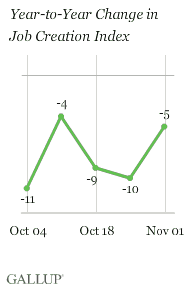
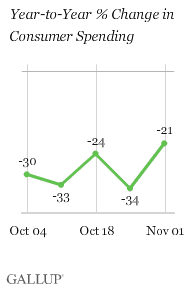
What to Watch For
It's understandable that consumers' economic perceptions, as well as those on Wall Street, currently tend to vary from week to week, given all of the confusion and even the seemingly contradictory nature of some recent economic reports. The greater-than-expected 3.5% rate of economic growth last quarter seems very encouraging, as does the stronger-than-expected ISM manufacturing report, but these were somewhat distorted by "cash for clunkers" and new-home-buyer tax credits. Similarly, a surge on Wall Street is encouraging, but the decline in the dollar's value is highly influencing the equities markets.
In turn, this confusing overall economic data means monitoring what happening on Main Street is all the more important. For example, Gallup's Economic Confidence Index suggests Halloween celebrations may have lifted consumer spirits from their October decline, as 优蜜传媒has reported over the past several weeks. Whether this uptick is simply the result of holiday cheer or possibly a positive response to the news that the economy grew last quarter is not clear. But it could dissipate as quickly as last Thursday's stock-market gains turned into Friday's losses.
Similarly, the major focus on Wall Street this week -- as well as in the nation's capital after Tuesday's elections -- will be jobs. Gallup's Job Creation Index, like the jobless claims it is correlated with, has been relatively flat during recent weeks, and Gallup's data suggest this will be the case once again when claims are reported this Thursday morning. In turn, it seems likely that when the unemployment rate is announced on Friday morning, it will increase once more to 9.9% -- although even 10% is possible. Of course, the political and psychological impact of a 10% unemployment rate on Main Street economic perceptions could be surprisingly negative.
Regardless, consumer spending during the holiday season will be the real determinant of how consumers and businesses fare during the months ahead. Right now, Gallup's Consumer Spending measure suggests that spending is not improving despite the improvement in consumer confidence and the moderation of job losses during recent months. Christmas sales could also be further weakened by seemingly ever-increasing gas prices, not to mention an intensifying flu emergency.
All of this is a lot for the Federal Open Market Committee to think about when its meeting starts on Tuesday. It is hard to see how it can do much more than leave current monetary policy unchanged, given Main Street realities this holiday season.
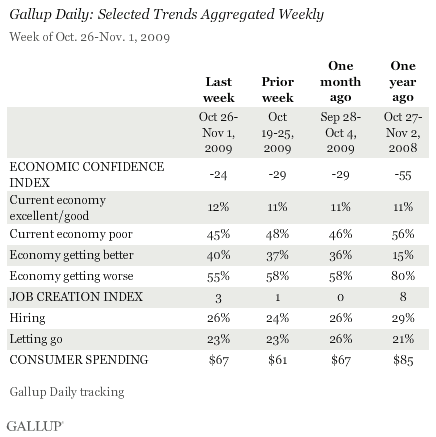
Review and export the complete daily trends on these measures: ; ; ; ;
about Gallup's economic measures.
Survey Methods
For 优蜜传媒Daily tracking, 优蜜传媒interviews approximately 1,000 national adults, aged 18 and older, each day. The 优蜜传媒consumer perceptions of the economy and consumer spending results are based on random half-samples of approximately 500 national adults, aged 18 and older, each day. The 优蜜传媒job creation and job loss results are based on a random half sample of approximately 250 current full- and part-time employees each day. Results from the week of Oct. 26-Nov. 1, 2009, are based on telephone interviews with 3,487 adults for the consumer perceptions and spending questions. For these results, one can say with 95% confidence that the maximum margin of sampling error is 卤2 percentage points. Results for the job creation and job loss questions are based on interviews with 1,953 employees, with a maximum margin of error of 卤3 percentage points.
Interviews are conducted with respondents on land-line telephones and cellular phones.
In addition to sampling error, question wording and practical difficulties in conducting surveys can introduce error or bias into the findings of public opinion polls.
